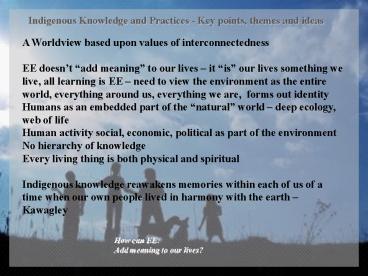How can EE: PowerPoint PPT Presentation
Title: How can EE:
1
Indigenous Knowledge and Practices - Key points,
themes and ideas
A Worldview based upon values of
interconnectedness EE doesnt add meaning to
our lives it is our lives something we live,
all learning is EE need to view the environment
as the entire world, everything around us,
everything we are, forms out identity Humans as
an embedded part of the natural world deep
ecology, web of life Human activity social,
economic, political as part of the environment
No hierarchy of knowledge Every living thing is
both physical and spiritual Indigenous knowledge
reawakens memories within each of us of a time
when our own people lived in harmony with the
earth Kawagley
How can EE Add meaning to our lives?
2
Indigenous Knowledge and Practices - Key points,
themes and ideas
ManyWays of Knowing, Teaching and
Learning Two-eyed Seeing - Integrative
thinking Recognize and support self identity in
EE Importance of place and a sense of
place Cross cultural education, building of
dialogue between identities Learning to see
from one eye with the strengths of Indigenous
knowledges and ways of knowing, and from the
other eye with the strengths of Western (or
Eurocentric or mainstream) knowledges and ways of
knowing and using both these eyes together, for
the benefits of all. Elder Albert Marshall,
Eskasoni Community Mikmaq Nation
How can EE Contribute to social innovation?
3
Indigenous Knowledge and Practices - Key points,
themes and ideas
Reciprocity, Respectful, Relationality
partnership and collaboration towards policy
change and concrete action How to Share
Knowledge Protocols needed for each cultural
group and many aspects are sacred (not all for
public consumption) Decolonization and
Cultural Revitalization for Indigenous and
Non-Indigenous Peoples circular
relationships Knowledge embedded in Language
Multiple Voices within the Indigenous
Population polylogue
How can EE Contribute to political innovation
and influence public policies?
PowerShow.com is a leading presentation sharing website. It has millions of presentations already uploaded and available with 1,000s more being uploaded by its users every day. Whatever your area of interest, here you’ll be able to find and view presentations you’ll love and possibly download. And, best of all, it is completely free and easy to use.
You might even have a presentation you’d like to share with others. If so, just upload it to PowerShow.com. We’ll convert it to an HTML5 slideshow that includes all the media types you’ve already added: audio, video, music, pictures, animations and transition effects. Then you can share it with your target audience as well as PowerShow.com’s millions of monthly visitors. And, again, it’s all free.
About the Developers
PowerShow.com is brought to you by CrystalGraphics, the award-winning developer and market-leading publisher of rich-media enhancement products for presentations. Our product offerings include millions of PowerPoint templates, diagrams, animated 3D characters and more.

